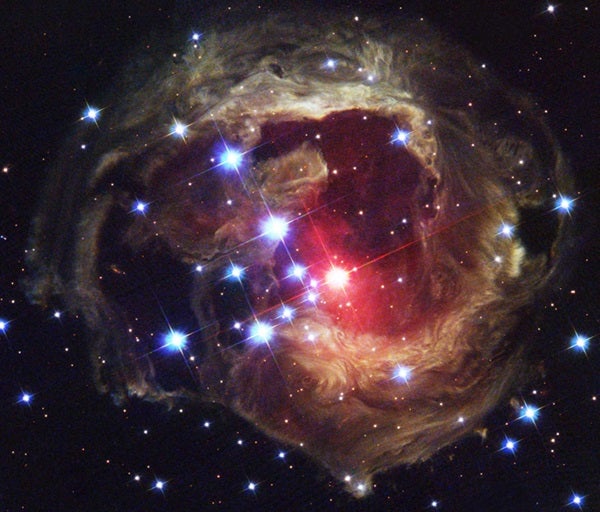Astronomers are still debating the nature of a January 2002 outburst from a faint star in the constellation Monoceros. The star, designated V838 Mon, suddenly brightened to 600,000 times the luminosity of our Sun and became one of the brightest stars in our galaxy until it finally faded in April 2002. Despite 3 years of monitoring the star and its environment, astronomers remain unsure why the outburst occurred.
“There’s not a whole lot that astronomers agree on about V838 Mon,” Howard Bond of the Space Telescope Science Institute in Baltimore, Maryland, told Astronomy last year. Since then, astronomers have made some progress in understanding the star’s environs, although there remains little agreement on the cause of the outburst.
As the pulse of light from the outburst spread away from the star, it illuminated delicate shells of dust. Bond has been using the Hubble Space Telescope (HST) to monitor this expanding “light echo,” which is revealing the complex patterns in V838 Mon’s dusty shell much like a medical MRI unveils a patient’s tissue. Astronomers released a new Hubble “spot check” on V838 Mon, taken in October 2004, earlier this month.
V838 Mon’s spectacular outburst and light echo sparked an international observing campaign. A team led by Ulisse Munari of Italy’s Observatory of Padova, and which included Bond, used optical and infrared measurements to pin down the star’s distance. The astronomers found V838 Mon lies about 32,000 light-years from Earth, about 57,000 light-years from the Milky Way’s center, and stands about 2,000 light-years above the galaxy’s disk.
Some astronomers have argued the outburst is lighting up interstellar dust — ambient clouds that happen to lie near the star. Yet Hubble’s most recent images include background galaxies, just the opposite of what one would expect if a broad dust cloud were in the neighborhood. If the material isn’t ejected by the star, says Bond, “then I don’t understand why the dust appears to be concentrated around the star, nor why, in the image just released, there appear to be two bright concentrations on opposite sides of the star, at the top and bottom of the new image.”
There is no lack of ideas for what caused V838 Mon’s outburst. One group has attempted to explain the eruption as the merger of two unequally matched main sequence stars: The more massive star expanded and cannibalized its low-mass companion.
Others have argued for a similarity with classical novae. “A nova ejects its envelope at high velocity and quickly exposes a hot core, while V838 Mon remained very cool throughout the event,” notes Bond.
Alon Retter of Pennsylvania State University maintains the star expanded to a red giant and flared when it engulfed three nearby Jupiter-like planets. Retter and colleagues argued at January’s meeting of the American Astronomical Society that planet-swallowing “probably has a significant impact on the evolution of stars and should be considered in theoretical models.” Critics counter the planets couldn’t reach the star’s center fast enough to account for the flare-up’s high energy output.
As a star like our Sun reaches the end of its energy-producing life, it becomes a red giant and ejects much of its mass in a series of thermal pulses. The last pulse throws off what’s left of the star’s gaseous envelope, forming a planetary nebula, while the star’s core collapses to form an Earth-size white dwarf. V838 Mon fits the bill as such an “asymptotic giant” but for one thing: A young, massive star orbits it.
The B-class star orbiting V838 Mon exhausts its fuel much faster than a Sun-like star. So, the fact that V838 Mon has a young, massive stellar companion implies that it, too, is a young, massive star.
“There is increasing support for the idea that V838 Mon may have had its origin in a fairly massive star,” Bond says. “So, perhaps — and this is a real speculation — the outburst is something that happens in those rare stars on the borderline between stars that explode as type II supernovae, and those that end as white dwarfs.”
Last May, Munari and Observatory of Padova colleague Federico Boschi compared V838 Mon’s outburst with a stellar event in the Andromeda Galaxy (M31). In 1988, astronomers discovered an unusual outburst from a red star in the bulge of M31. This object has been known as M31-RV (“red variable”) ever since.
“The case of M31-RV is particularly striking, since we know its distance,” says Bond. Indeed, taking the 2.5-million-light-year distance of M31 into account, the two events reached a remarkably similar maximum brightness. “As it happens, there is an HST image in our archive showing the location of M31-RV,” he notes. The image was taken for another purpose, so it’s just luck that the peculiar star happens to be in the field of view. The field is crowded with other stars, which complicates the search for a possible light echo; none has not been found so far.
Several groups continue to monitor the development of V838 Mon’s light echo using ground-based telescopes, and this will eventually allow astronomers to construct a three-dimensional map of the dust distribution. “This ought to at least settle the question whether the dust was ejected from the star or not,” Bond says. “We have also submitted a proposal to get more intensive observations with Hubble, rather than the occasional snapshots we have obtained to date.”










